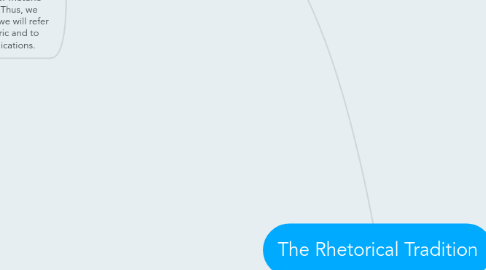
1. The Origins Of Rhetoric: Originated in Athens, Greece, sometime around the fifth century BCE.
1.1. Rhetoric In Ancient Greece: Aristoltle, a student of Plato and one whom many scholars credit with being the first theorist of rhetoric, disagreed that persuasive technique was only a way of making " the weaker case the stronger"
1.1.1. Techne: an art or technque
1.1.1.1. Rhetoric and logic are necessary counterparts. Rhetoric and logic are not opposites but mutually complementary and necessary counter parts: logic requires persuasion, and persuasion requires logic.
1.1.1.2. The form and function of speeches are shaped by the possible speech goals. The logic and coherence of speeches are determined by their goals. To clarify this point, Aristotle classified different kinds of speech by their purposes: Forensic, Epideictic, and Deliberative.
1.1.1.2.1. Forensic: for use at a trial.
1.1.1.2.2. Epideictic: for use at a funeral.
1.1.1.2.3. Deliberative: For use in the senate.
1.1.2. Rhetoric can be treated as a coherent area of inquiry. Rhetoric is not simply a collection of techniques for slick speech; it also has a logic and a purpose as the "faculty of observing the available means of persuasion in any given situation.
1.2. Rhetoric Across the ages.
1.2.1. 1st century BCE. Cicero, a Roman orator, philosopher, and statesman, wrote extensively on rhetoric and specifically oratory.
1.2.2. 4th century CE. Augustine of Hippo, a theologian and saint of the Catholic Church, picked up where the Greeks and Romans left off, arguing that philosophy and theology required rhetoric as a way of making truth intelligible to people who were not theologians or philosophers.
1.2.3. 14th century CE to the 17th century: During the Renaissance, rhetoric flowered and rhetoricians turned to the arts of speech and letter writing as part of a new commitment to eloquence in the courts, palaces, and salons of king and other leaders.
1.2.4. 17th and 18th centuries: Thinkers such as Thomas Hobbes, John Locke, Jean-Jacques Rousseau, Giambattista Vico, Hugh Blair became increasingly interested in the relationship among rhetoric, politics, human knowledge, and human nature.
